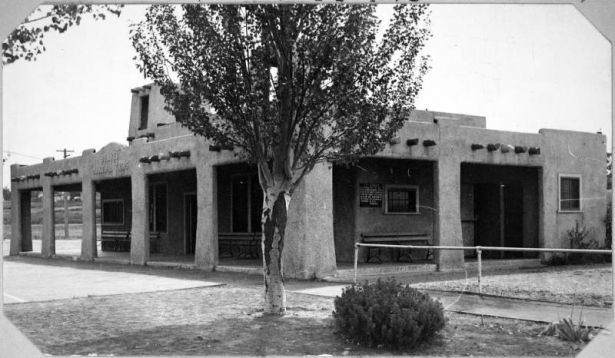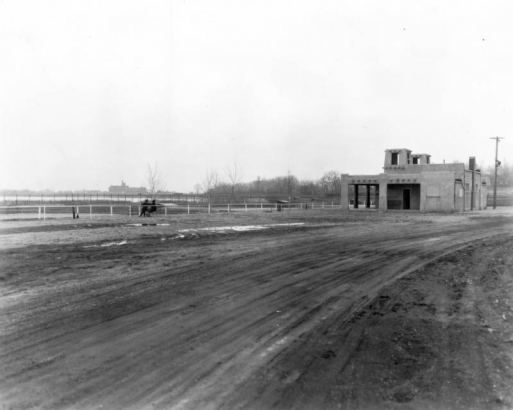Have you ever wondered, "What is that adobe building on the southwest corner of Sloans Lake; the one near the torpedo monument?" If you have, you're hardly alone. This architectural oddity is vexing to both Denver newcomers and natives.
The answer however, is not one you'd come up with unless you guessed for a very long time.
From 1923 until 1969, the building located on the corner of (roughly) 17th Avenue and Sheridan Blvd. was home to the Denver Municipal Trap and Skeet Club. That's right, for many years the sound of shotgun blasts reverberated safely over the waters of Sloans Lake.
In 1921, the members of the Denver Trap Shooter's Club approached City Superintendent A.K. Vickery and asked for a trap range. They were no longer able to occupy their former clubhouse in what would later become Aurora.
Vickery was more than willing to accommodate the club and immediately offered up the site on the southwest corner of Sloans Lake.
He went on to praise the sport. "Trap shooting is one of the cleanest of sports and attracts a class of men who are counted among the best citizens of any community," according to Denver Municipal Facts.
In 1923, the clubhouse and trap range opened to the public. The clubhouse - that distinctive adobe building - was similar to clubhouses found at Denver golf courses; they hosted banquets and offered apres' shooting beverages. Denver's civic skeet club remained in operation until around 1969 when a combination of noise complaints and financial woes forced the operation to move out. By 1970, the City was busy dredging leftover lead from the bottom of the lake.
Wait, that wasn't safe, was it?
While the idea of sport shooters firing live rounds over Sloans Lake sounds strange to contemporary ears, it's not quite as extreme as you might think. Consider that the area around Sloans was nowhere near as populated in 1923 as it is today. It was literally the edge of town, as these photos show.
Consider also the location of the range on the far southwestern corner of the lake. From that corner to the north/northeast corner of the lake is approximately 5,173 feet.
There are a lot of variables that determine how far buckshot travels, including the gauge of the gun, the size of the shell's load, the weather, and the angle of the gun as it's being fired. But, assuming a person was firing 00 or 0 buckshot from a 12 gauge shotgun (a pretty standard load for skeet and trap shooting), his or her shot would likely travel less than 2000 feet. That places the pellets well short of the other side of the lake. (Remember, these numbers are approximate.) So injuring bystanders wasn't likely.
Though the idea of a civic trap-shooting range might not resonate with modern Denverites, it wasn't such an odd idea in the 1920s. During that decade, the city experienced rapid growth and prosperity and was quite open to facilities and sporting clubs that promoted civic life. Not long after the trap club was approved, the City okayed a proposal to allow fly fishing clubs to use the pool at Sunken Gardens Park to practice casting.
Civic skeet shooting hasn't endured as a component of Denver Parks and Recreation, but the building that housed the Denver trap range seems likely to be with Denverites for a very long time to come.




Comments
In December 1970, I was 6…
In December 1970, I was 6 years old and my family would take me to the north side of Sloans Lake and we would ice skate in the Sloans Lake Marina after the Willy’s Jeep and snow plow would clear the snow off the ice. Steel drums would be burning firewood on the banks where you could warm yourself and families would have roasted nuts and hot chocolate.
My ice skates were double bladed to keep me from falling so easily.
I’m a native of Denver since 1964!
Not only the shot landed in…
Not only the shot landed in the lake. If a clay pigeon was not hit it, too came down in the lake and - landing in water - generally survived completely intact. As kids, we would ride our bikes over to the range on days when it was not in use, wade out into the lake, and collect the intact pigeons.
As a Jr. High school student…
As a Jr. High school student work at DMTC. Got to meet Bing Crosby. It was told that the club was closing to allow the building of a Nursing Home.
As a kid, I started by …
As a kid, I started by "setting trap", and then graduated to "pulling". Multiple day shooting competitions paid like $12.00. Eddie Bohn Jr. lived across the street and his father boxed in the area. Eventually opening a restaurant, Eddie Bohns Pig and Whistle.
Add new comment